Lens Aberration Correction Function
Some lens characteristics could cause the periphery of images shot to become darker than the center, or cause the subject to be distorted. In such cases, you can use the lens aberration correction function of Digital Photo Professional. Using this function, you can improve the following phenomena, which cannot be completely eliminated in the lens structure, to make images that are closer to what you intended.
Phenomena that can be corrected:
- Diminished peripheral illumination (the amount of light at the periphery of an image)
- Distortions (distorted lines)
- Chromatic aberration (color fringing that occurs in the periphery of an image)
- Color blur (blue or red color blur that sometimes occurs at the edge of the highlighted area of an image)
NOTE
- You can also correct RAW images taken with the compatible lens even when the extender is attached.
- You can also correct RAW images shot with EF 50mm f/2.5 Compact Macro fitted with Life Size Converter EF.
- The aberration correction function is not available for images shot with a lens other than those given under "Compatible Lenses". They are therefore not displayed and cannot be used.
- The lens aberration correction function is not available for multiple-exposure RAW images created on the camera.
- EF cinema lenses (CN-E lenses) are not compatible.
Correcting Lens Aberration
Follow the procedure below to correct lens aberration.
1. Start Digital Photo Professional Ver. 4.x and display the main window.
2. In the main window displayed, if you double-click the RAW image to be corrected, the edit screen and tool palette appear.
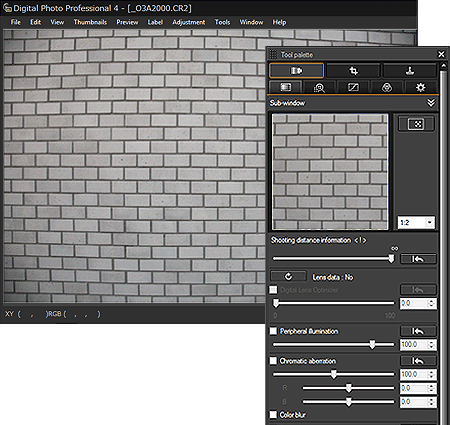
REFERENCE
If the tool palette does not appear, select [Tool Palate] from the [View] menu on the toolbar.
3. Select the [

] tab and checkmark the items to be corrected.
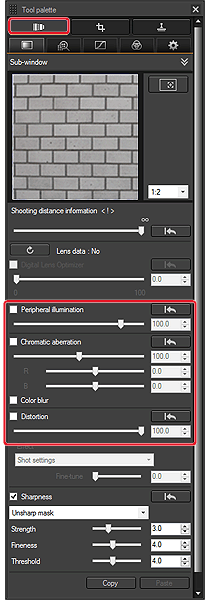
4. [Peripheral Illumination] and [Distortion] have been selected in the example image below.
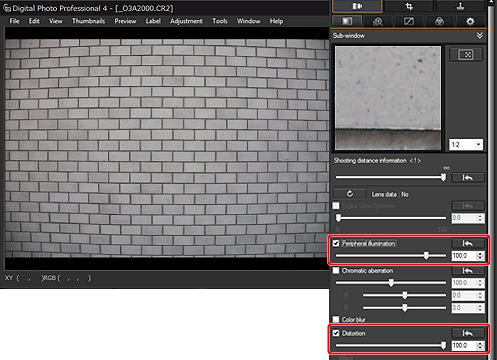
5. The image is corrected and redisplayed.
To adjust the correction amount, drag the slider from side to side.
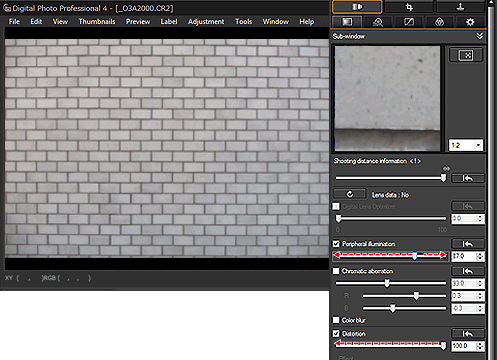
REFERENCE
You can correct red chromatic aberration with the [R] slider of the [Chromatic aberration] or blue chromatic aberration with the [B] slider.
When you have finished making corrections, click [OK].
6. When closing the [Lens aberration correction] window, the result of the corrections is reflected in the image in the edit window, and the image is redisplayed.
In the main window, the [

] mark is displayed on the image to indicate the lens aberration corrections.
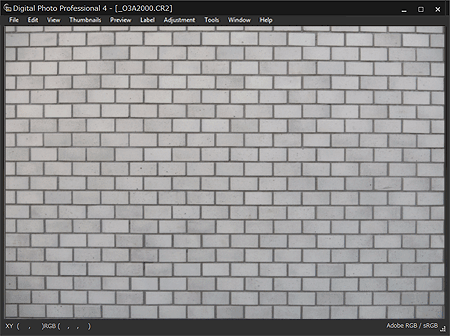
Thumbnail Image Displayed in the Main Window
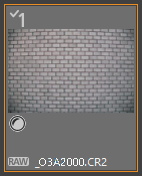
NOTE
The Shooting Distance Information Slider
- When correcting RAW images and if shooting distance information has been saved to the image, the slider is set automatically according to this shooting distance information. However, if no shooting distance information is saved to the image, the slider is set automatically to the right end at infinity position and a [<!>] appears above the slider.
- If the imageâs shooting distance is not infinite, you can minutely adjust the distance by operating the slider while looking at the screen.
For RAW images shot with MP-E 65mm f/2.8 1-5x Macro Photo or EF 50mm f/2.5 Compact Macro with Life Size Converter EF, the slider indicator changes to [Magnification factor].
- [Shooting distance information] slider is applied to all the correction items with check marks.